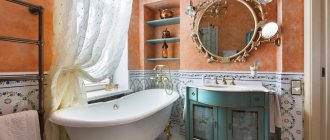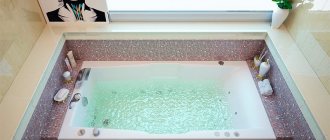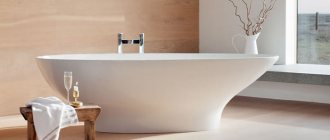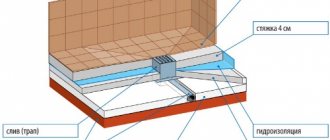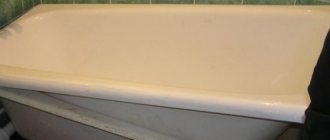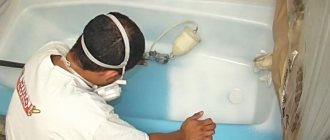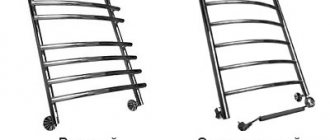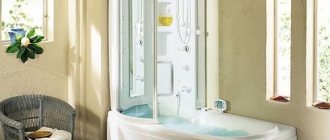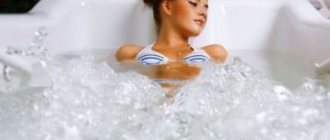If you want to update your bathroom, you naturally want the new bath to be comfortable, beautiful and durable.
An acrylic bathtub in this case will be an excellent solution. Such bathtubs of a wide variety of shapes and colors can now be purchased at many plumbing stores.
However, when trying to find the answer to the question of which acrylic bathtub is better, you can come across the most contradictory reviews. There are opinions about the lack of strength of acrylic bathtubs and instability to scratches (it has been noticed that such doubts are often expressed by people who do not have an acrylic bathtub at home).
What are acrylic facades?
At first glance it may seem that the panels are made of plastic. This is wrong. Thin MFD or chipboard panels are covered with special sheets of polymethacrylate, more often called acrylic.
MDF panels coated with acrylic.
This helps to ensure not only strength, which is important for furniture facades, but also wide design possibilities, as well as a characteristic glossy shine. MDF with acrylic coating is absolutely harmless, does not emit toxins when heated, and with proper care will last for many years.
High-gloss acrylic panels are easy to clean and do not fade over time. In addition, the properties of acryline help it not to absorb dirt and grease.
Cast acrylic bathtub
The most durable, but also the most expensive to produce, are bathtubs made of cast acrylic.
In this case, the acrylic sheet is made using the above technology from a liquid PMMA base by polymerization. Sheet thickness varies between 4-6mm.
A bathtub made of cast acrylic has two layers: the acrylic itself and a reinforcement layer. In higher quality products, the reinforcement is made not of fiberglass, but of polyurethane composite.
Such bathtubs are usually distinguished by a simpler form of the product, since they do not require additional stiffening ribs disguised as artistic bends.
The undoubted advantage is the high density of the material, pleasant smoothness of the surface, and the absence of micropores where dirt and bacteria can linger.
If scratches appear on the surface, they are much easier to repair or simply sand. Since cast acrylic is homogeneous, a slight decrease in the thickness of the bottom or side will not lead to any dire consequences.
The disadvantages include the price. Another controversial drawback: there is an opinion that cast acrylic is less resistant to impact than extruded acrylic.
Indeed, you can find a description of experiments where a metal weight weighing 800g was dropped into a bathtub, and extruded acrylic withstood the drop of the load from a greater height, but cast acrylic did not.
But, excuse me, 800g is the weight of a heavy plumber’s hammer, which can just as easily split a cast-iron bathtub and hopelessly cripple a steel one.
Checking an acrylic bathtub with a hammer - video
As you can see from the video, the bathtub successfully passes the test, so decide for yourself whether acrylic bathtubs are considered durable or not.
Manufacturing technology of acrylic facades for kitchens
There are two ways to manufacture such facades: one-sided and two-sided. In the first case, the acrylic sheet is glued only to the outer part, leaving the inner part untreated. In the second, both sides of MDF or chipboard are glued, providing the doors with the same appearance from the inside and outside.
The coating is glued using a special glue (for example, Cosmofen or Akrifix), and then placed under a press. In this case, the sections are covered with a waterproof acrylic edge, which prevents peeling of the decorative layer. The thickness of such a facade often does not exceed 16-18 millimeters.
A more expensive option is solid acrylic panels up to four millimeters thick, edged with aluminum. Metal adds strength to them, comparable to chipboard, but they are much more difficult to maintain and are quite expensive.
Types of acrylic products
There are 3 main types of products. Each type has its own characteristics, advantages and disadvantages. The following options can be seen on the market:
- Gypsum acrylic.
- MDF acrylic.
- Decoacrylic.
Let's look at them in detail.
Gypsum acrylic
This type of material is often used for wall decoration in public buildings. As a material, gypsum acrylic appeared about 10 years ago. This is a good alternative to gypsum vinyl and similar decorative finishing materials. Area of use: finishing walls in a building, covering ceilings, applying to door and window slopes.
As the name implies, such products are based on a sheet of plasterboard. This has a positive effect on its strength characteristics. But it also has its drawbacks: gypsum is afraid of moisture. Therefore, the use of this type of finish for the kitchen and bathroom (as well as for other wet rooms) is unacceptable.
MDF-acrylic
The process of creating this type of product was described above. This is not in vain, since MDF acrylic is the most common type of acrylic wall panels. It's all about the versatility and excellent characteristics of the products. The material is not afraid of dampness and can be installed in saunas, baths, kitchens and bathrooms.
MDF is a durable material, thanks to which the panels are resistant to mechanical damage, deformation, bending and physical stress.
Decoacrylic
In appearance, such acrylic wall panels resemble translucent plexiglass, the surface of which is glossy or matte. The thickness of the product is small - 4–12 mm. The performance characteristics of decoacrylic are much higher than those of glass. The product is resistant to mechanical factors and is lightweight.
Advice! Due to the strength of decoacrylic, it is easy to process. The panels can be drilled, sawed and bent.
The main feature of dcoacrylic is its high ability to transmit sunlight and light. The material is useful for creating transparent or translucent partitions. And due to their resistance to negative external factors, the panels are used for facades.
Pros and cons of kitchens with acrylic facades
In addition to appearance and ease of installation, such facades have a number of advantages:
- Wear resistance. The strength of acrylic reliably protects it from damage due to impacts and scratches. In addition, damaged acrylic panels can be reconstructed to their original appearance. With proper care, they will last up to 20 years.
- Acrylic does not react to temperature changes and is resistant to heating up to 160 degrees. It does not deform when exposed to water, and does not fade from sunlight.
- Grease, soot and dust are not absorbed into the surface ; it can be easily cleaned with a simple detergent and a soft cloth. We recommend: Once every three to four months, treat facades with sprays that help maintain a glossy shine, for example, Weiss or Cosmofen.
- Large selection of design solutions. Acrylic panels are presented in a wide palette. In addition, you can decorate them with prints or airbrushing or decoupage.
- The glossy structure due to its reflective properties makes the room lighter and more spacious .
- Acrylic panels, unlike plastic ones, do not release toxic impurities into the air when heated. Therefore, acrylic can be considered an environmentally friendly material.
However, it was not without its drawbacks:
- Due to the manufacturing technology, acrylic facades are quite expensive . The cost of a solid acrylic facade can reach $600 per linear meter, and an acrylic coating can cost $100. At the same time, taking into account the quality, the price can be considered relatively affordable: the long service life fully pays for the costs of manufacturing and installation.
- The glossy surface is very difficult to handle. It does not scratch or chip, but any fingerprints and dust become much more noticeable. You will have to regularly wipe away streaks and stains. Please note: Special grease-repellent polishes will help prevent the problem.
- High shine. The disadvantage is conditional, but over time many people begin to be annoyed by the glossy mirror structure of the acrylic facade.
What is the difference between cast acrylic and extruded acrylic?
Extruded acrylic is essentially the same acrylic, but the sheet material for making bathtubs is produced not by polymerization, but by high-temperature pressing from acrylic granules.
This technology significantly reduces the cost, acrylic sheets are of uniform thickness and are better shaped during the production of products. The resulting material is more porous than cast acrylic, although it is not so easy to visually distinguish the first from the second.
In this case, responsibility for quality lies not even with the manufacturer of the bathtubs, but with the manufacturer of sheet acrylic.
In a number of Western European countries, the production of bathtubs and products from extrusion materials in contact with human skin is prohibited. However, it should be noted that in these same countries, shower trays, shower panels and bath screens are made from extruded acrylic.
In Eastern Europe and Asia there are no bans on the use of extrusion materials.
When choosing a bathtub made of extruded acrylic, you should pay attention to the manufacturer. Eastern European companies produce quite decent quality products from acrylic sheets produced in Europe.
In this case, the advantage is a large selection of bathtubs of different shapes and sizes, at a price significantly lower than products made from cast acrylic. At the same time, the strength and appearance of the bath fully comply with accepted standards.
The disadvantage is that the service life declared by the manufacturer is shorter than for acrylic bathtubs made by injection molding - 4-5 years.
If the bathtub is made by a little-known Asian company, you should be especially careful when purchasing. Since the manufacturer has taken the path of reducing the cost, you need to pay attention to the quality of the reinforcement, the thickness of the material, especially in places of bends, and the design of the metal frame.
Better yet, ask the seller for a certificate of conformity.
In general, when faced with a choice between extruded acrylic or cast acrylic, we can say that a high-quality bathtub made of extruded acrylic is quite a worthy purchase in terms of price-quality balance, but in absolute characteristics it will be somewhat inferior to cast one.
What is better to choose for kitchen facades: acrylic or plastic?
As mentioned above, acrylic is much more environmentally friendly than plastic. But is this the only difference? We offer a comparative table of the two materials.
| Acrylic facades. | Plastic facades. | |
| Gloss. | Clearly expressed, with a mirror shine. | Compared to acrylic, plastic is duller. There are matte options. |
| Temperature resistance. | It tolerates heating up to 160 degrees without releasing toxic impurities. | Good HPL or CPL plastic can withstand temperatures up to 140 degrees, but cheap options begin to release toxins at 80 degrees, so they should not be placed near the stove. |
| Term of use. | With proper use - up to 20 years. | After just a couple of years, it may begin to fade from heat and direct sunlight. |
| Price. | High-quality acrylic will cost you quite a lot. | Affordable price. |
| Facade type. | Only deaf. | Deaf and radius. |
Let's summarize: Acrylic facades are more durable and reliable, but the price is not encouraging. At the same time, plastic facades are more affordable, but they are more capricious in everyday use and they cannot be placed next to heat sources.
Production and origin
Acrylic paints appeared on the market relatively recently. Scientists, in the process of splitting acrylic acid, were able to isolate a substance that became the basis for the manufacture of the polymer. It is a pure synthetic material. It has a transparent texture and excellent technical properties. The material does not have a pungent odor. It is very durable, tolerates thermal changes well, and is not afraid of ultraviolet radiation.
Using acrylic resins, manufacturers have learned to produce paints and paints. They prepare a solution, add a polymer dispersion, a binder, and a coloring pigment to it. The result is a material, after application of which a film is formed on the surface being treated that can protect against external factors. This paint adheres very well to the base and has a high degree of adhesion. Its quality depends on the type of acrylic resin and the fillers used. With their help, the viscosity of the paint and its matting are “formed”.
Polymer base for the production of acrylic paints Source svopi.ru
This indicator is adjusted by adding a solvent. When deciding how to dilute acrylic paint, you need to carefully study the manufacturer's instructions. The main parameters of the composition are indicated there, the scope of its use is indicated, and the main stages of preparing the paint for construction work are listed. The composition of acrylic paints provides their advantages:
- They are environmentally friendly and do not contain substances hazardous to human health.
- They are easy to work with, the compositions are applied in an even layer and dry quickly.
- The paints are odorless, so you can work with them even indoors.
- The materials are not prone to fire, they do not contain flammable substances.
- The ability to add pigments allows manufacturers to produce paints in a wide color palette. Today, using them you can not only paint various types of surfaces, but also create colorful paintings. What makes artists who paint walls and ceilings happy?
Acrylic paint colors Source giveart.ru
- The time for complete drying of one layer is three hours.
- After application, a film that is resistant to abrasion is formed on the surface. The color does not fade in the sun.
- The painted surface does not lose its attractiveness for ten years.
- The composition of the paint is unique; after application, its layer reliably protects the surface from moisture, while it allows air to pass through well.
- Painted areas are easy to clean, dirt particles do not stick to them, so the maintenance process is noticeably simplified.
Versatility and versatility provide a wide range of applications. Experts, talking about what acrylic paints can be used for, draw attention to the fact that they can paint metal and wood, concrete, a layer of decorative plaster and even fabric. With their help, tuning of passenger cars is carried out. They are used by manicurists and pedicurists to create amazing nail designs. There are restrictions on some types of plastic, but otherwise there are no prohibitions.
Wall art painting Source remstatus.ru
See also: Catalog of house projects for which painting was used.
What color should acrylic facades be made in?
The design palette for acrylic facades is extremely wide. Many colors and shades, the possibility of decorative design. We invite you to look at the most popular options among designers - perhaps you will find your ideal kitchen.
A white acrylic kitchen is a great choice for small spaces. Due to the color and glossy texture, it reflects light, visually enlarging the room and making it lighter and more spacious. However, keep in mind that such facades are very difficult to maintain - all the dirt and drops of grease are visible on the white surface, so you will have to wash the set often.
An interesting solution is a black and white acrylic kitchen . The classic combination looks very catchy thanks to the mirror shine. However, it is important to maintain a balance here: it is better if the colors are combined with each other, and do not overwhelm each other.
If such a combination seems boring to you, dilute it with another shade - it is better to choose bright colors, for example, pink, light green, blue.
Bright red is on trend right now, but we recommend being careful with it. Aggressive tones quickly tire the eyes, so monochromatic design in this case is not the best choice. Dilute it with calmer, pastel shades - beige, gray, golden.
The same applies to yellow kitchens . However, it all depends on the chosen tone. Soft colors will make the kitchen fresh and brighter, but bright colors require a muted edging.
A monochrome black kitchen is a bold but very stylish solution. It is important to pay attention to details: any inappropriate accessory, the slightest contamination - and the impression is ruined.
How to prepare the composition for painting
Any enamels must be diluted before application. Not everyone knows how to dilute acrylic paint. The manufacturer does not always indicate this item in the technical data sheet. If there is no additional information, you can dilute the paint with plain water. When the 1x1 ratio is selected, the ideal composition for priming the base is obtained.
If you need to apply a very thin layer that will lie evenly on the surface, experts advise adding two parts of water (200 ml per liter). The more water, the thinner the paint layer will be.
Note! The paint must be diluted in a separate container. You cannot pour water into the jar straight away. In such a situation, it will be difficult to control the consistency of the finished composition. Acrylic diluted with water cannot be stored. Once dry, it becomes unusable.
Water is the best base for acrylic paints Source kraskaok.ru
Hot boiled water is the best thinner for acrylic paints that are dried and unused. To “reanimate” them, you need to grind the dried paint into powder, and then pour boiling water into it. Leave for a few minutes, drain, and repeat the procedure again. After the paint has softened well, excess water is poured out, everything that remains in the container is thoroughly stirred. Of course, after such “reanimation” the material partially loses its properties, so experts do not recommend using it for painting “ceremonial” places. However, if you need to improve the appearance of an old shed, paint will do just fine.
Manufacturers of acrylic kitchen facades
Acrylic panels are produced by dozens of manufacturers with very different pricing policies.
We offer you the TOP 3 manufacturers popular in Russia:
- Bel Viso using NIEMANN panels. Polish acrylic facades are one of the most famous. A wide selection of decorative designs, a huge color palette and high quality. The price, however, is appropriate - from $150 per linear meter.
- The Sidak company , located in the Leningrad region, will also not please you with the price tag - from $140 per meter. However, the factory goes through the full production cycle: from the panel to the finished facade, which affects the quality.
- Fordom is a more budget option. Turkish facades will cost you an average of $90 per meter. Of course, you can also find cheap acrylic facades. But be careful - most often the tempting price tag hides a low-quality coating or simple plastic, sometimes not even heat-resistant.
House projects with painting
Number of projects 463
- 5 rooms
- 2 bathrooms
House Project Fable
- To favorites
- 133.7² Total area
- 9 x 10m Construction area
from RUR 1,804,949
Construction period 90 days
- 5 rooms
- 2 bathrooms
House Project 12-140
- To favorites
- 140² Total area
- 10 x 8m Construction area
from 1,890,000 rub.
Construction time individually
- 5 rooms
- 2 bathrooms
Navarro House Project
- To favorites
- 320² Total area
- 17 x 18m Construction area
from 4,320,000 rub.
Construction time individually
- 3 rooms
- 2 bathrooms
House Project 50-273
- To favorites
- 273² Total area
from 3,685,500 rub.
Construction time individually
- 3 rooms
- 2 bathrooms
Olivine House Project
- To favorites
- 134² Total area
- 7 x 17m Construction area
from 1,809,000 rub.
Construction period 91 days
- 4 rooms
- 2 bathrooms
Scandinavian House Project
- To favorites
- 116.11² Total area
- 10 x 10m Construction area
from RUB 1,567,485
Construction time 83 days
- 5 rooms
- 2 bathrooms
Sosenki House Project
- To favorites
- 117² Total area
- 14 x 8m Construction area
from 1,579,500 rub.
Construction time individually
- 9 rooms
- 4 bathrooms
Vasily House Project
- To favorites
- 352.3² Total area
- 15 x 12m Construction area
from 4,756,050 rub.
Construction period: 172 days
- 6 rooms
- 2 bathrooms
Service House Project
- To favorites
- 139.5² Total area
- 10 x 11m Construction area
from RUB 1,883,250
Construction time individually
- 5 rooms
- 3 bathrooms
Jasmine House Project
- To favorites
- 283.42² Total area
- 19 x 12m Construction area
from RUB 3,826,170
Construction period 131 days
- 5 rooms
- 3 bathrooms
House Project 22-250
- To favorites
- 250² Total area
from 3,375,000 rub.
Construction time individually
- 2 rooms
- 2 bathrooms
House Project 36-147
- To favorites
- 147² Total area
from 1,984,500 rub.
Construction time individually
- 3 rooms
- 1 bathroom
Kupavna-Life House Project
- To favorites
- 145² Total area
- 12 x 13m Construction area
individual calculation
Construction period individually
- 6 rooms
- 2 bathrooms
Crystal House Project
- To favorites
- 274.2² Total area
- 17 x 16m Construction area
from 3,701,700 rub.
Construction period 141 days
- 6 rooms
- 4 bathrooms
Duplex House Project
- To favorites
- 215² Total area
- 8 x 16m Construction area
from 3,037,700 rub.
Construction period 60 days
- 4 rooms
- 3 bathrooms
Ottawa House Project
- To favorites
- 225.6² Total area
- 14 x 15m Construction area
from 3,045,600 rub.
Construction period 125 days
- 8 rooms
- 2 bathrooms
Klaus House Project
- To favorites
- 250² Total area
from 3,375,000 rub.
Construction period 126 days
- 3 rooms
- 1 bathroom
Half-timbered House Project 120
- To favorites
- 120² Total area
- 7 x 11m Construction area
from 3,129,687 rub.
Construction period 50 days
- 6 rooms
- 4 bathrooms
Family Nest House Project
- To favorites
- 537² Total area
- 25 x 24m Construction area
from 7,249,500 rub.
Construction period: 237 days
- 5 rooms
- 2 bathrooms
House project "Nadezhda"
- To favorites
- 151.1² Total area
- 10 x 10m Construction area
from 1,543,500 rub.
Construction period 30 days
View all projects
Let's talk about why acrylic paint is so popular today, what features it has, and what you need to know to choose a material to perform various construction works. We will talk about the advantages and disadvantages of acrylic-based paints, and reveal the features of the technology for working with them.
Acrylic paints for construction work Source interier-vyksa.ru
Reviews from real owners of acrylic kitchens
If you look at the reviews of people who bought acrylic facades for their kitchen, you will notice one common point - everyone admires their beauty and durability, but emphasizes the capriciousness of their care. Most often, this means the need for regular cleaning.
However, some people think that wiping the facade once a month is enough, but the only disadvantage is the cost.
And some people don’t like the need to use special care products.
Sometimes a change in shade depending on the lighting is noted. Therefore, be careful with pastel colors - in the twilight they may appear dull.
However, the reviews are unanimous on one thing - acrylic facades are reliable, durable and beautiful.
Scope of use
Due to the variety of types, acrylic panels are considered universal and can be used for various purposes. And thanks to their environmental friendliness, they can be installed even in children's rooms. The product is suitable for use in both private housing construction and office premises. The panels are often found in banking premises, educational buildings, restaurants and hospitals.
If we talk about private housing construction, then acrylic panels can be used in design:
- Kitchens;
- Bathroom;
- Hallway;
- Bedrooms;
- Living room;
- Children's room;
- Dressing room.
The use of acrylic panels in the kitchen and bathroom is especially important. These are special rooms because they have high humidity. There are always odors and water in the kitchen, which the products do not absorb; this is practical and expedient. Also, sheets are not afraid of steam in the bathroom. And if it is expensive to make a room entirely with panels, then you can use zoning of space, combining different materials, cheap and expensive.
How to care for acrylic facades
As can be seen from the reviews, the main problem with acrylic facades is their maintenance. How to properly care for the panels?
Now we'll tell you:
- Do not use aggressive abrasive detergents.
- When choosing what to wash the panel with, stick to the mildest possible detergents - for example, regular dishwashing detergent.
- Use lint-free soft cloths.
- Wipe the surface regularly to prevent fingerprints and dirt from accumulating on it.
- Use polish for acrylic kitchen facades - it will make cleaning much easier.
Let's summarize: With proper care, an acrylic facade is an excellent choice for kitchen design. A beautiful, eco-friendly and durable set will become a real decoration of the room. Among the disadvantages, we note the high price - however, taking into account the durability of such furniture, it is completely justified.
Installation work
As for the installation of panels, it is simple and even a beginner can do it. This type of work is called the “dry construction” method. Installation work must be carried out at the end of the renovation work. The process consists of the following steps:
- Preparatory work. The walls need to be cleaned of dirt and dust. If large cracks are present, they are sealed. If the wall has a slight curvature, this is not a problem, since the panels need to be installed on the created frame, which levels out all differences.
- Installation of the frame. The lathing is made of metal or wood, with a cross-section of 25 mm. Here the choice of material is not important, the main thing is to use only galvanized metal for the bathroom, because the wood will rot.
- All that remains is to complete the final stage - fix the panels using self-tapping screws on the sheathing. The work is somewhat reminiscent of covering with plasterboard or wood panels. Through holes must be hidden with plugs designed for this purpose. To cover internal and external corners, a connecting profile is used.
This completes the work. Acrylic panels will help not only hide all the imperfections of the walls, making them more attractive and presentable, but also protect them from negative influences. If you take care of the surface and smoke quality products in advance, then you can be sure that the finish will last more than 10 years. Since the work is done with your own hands, you can save on hiring workers, and with this money you can buy better quality products. Then the next repair will not have to be done soon.
Kitchens with acrylic facades photo examples
Types of facades
Acrylic panels for the kitchen differ in the way the ends are finished. This is an important question. Since the inner surface is always white, with an external contrasting layer the end of the panel will look, to put it mildly, unaesthetic.
Based on the finishing method, there are three types of panels:
- postforming;
- with edge;
- in an aluminum frame.
Postforming
When using acrylic film on both sides of the base, the material also covers the edges, which reduces the number of joints to a minimum and increases the service life of the facade slab. As a rule, the side ends are slightly rounded. But the upper and lower ones are sealed with a PVC or acrylic edge. This method is called postforming.
Edge finishing
When an acrylic panel is used, the ends on all sides must be sealed with an edge. The best option is an acrylic edge, since, unlike PVC, it is more durable.
In aluminum frame
The most expensive option. Ideal for modern style solutions such as hi-tech, techno, modern. This edge option further protects against deformation. Suitable for panels where the plastic layer is 3-4 millimeters thick. The only disadvantage of this design is even more frequent cleaning. Since the aluminum edge will get dirty even faster than the glossy panel itself, you will have to monitor its cleanliness more carefully.
Recommendations for care and use
Unfortunately, the perfectly smooth and shiny surfaces of facades quickly become dirty. They show small droplets of water and grease, as well as fingerprints. Therefore, daily surface care is a mandatory ritual if you want your kitchen set to always be beautiful and tidy. Otherwise, the “soul of the house” will irritate instead of delight.
Daily cleaning is quite simple: you need to wipe the surfaces with a soft damp cloth. Microfiber cloths are best suited for these purposes. If there are strong and persistent stains, you can additionally use a soap solution or a mild detergent.
Manufacturers do not recommend using chemical or abrasive products.
To add shine and remove stains from detergents, you can use glass cleaners containing alcohol.
I would also like to talk about acrylic polish. After all, no matter how carefully and carefully you try to use the surfaces, small scratches cannot be avoided. To add aesthetics to an acrylic set, you can purchase a polish specially created for this purpose in furniture stores. It will restore its original shine and hide minor damage.
